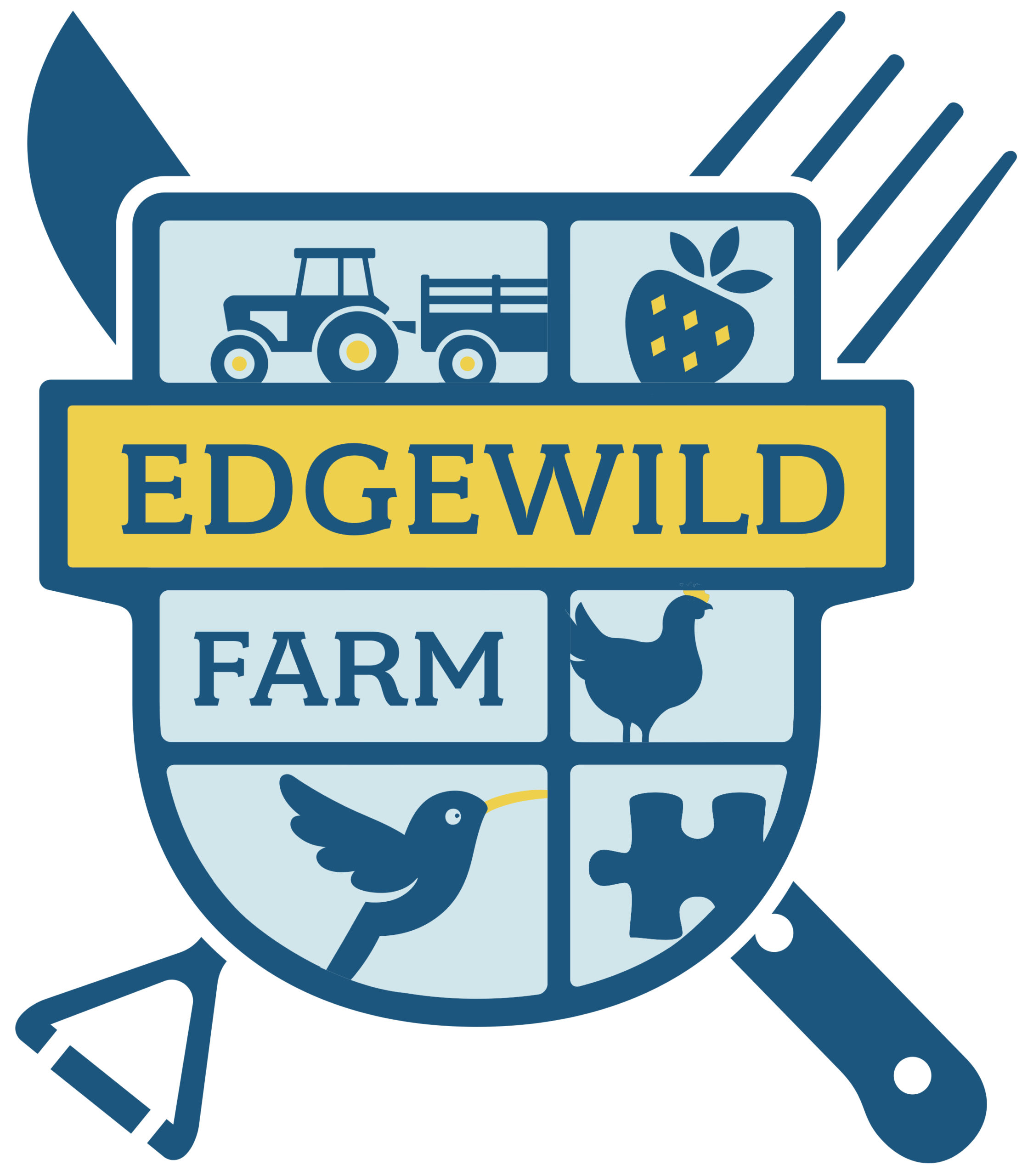State Fare
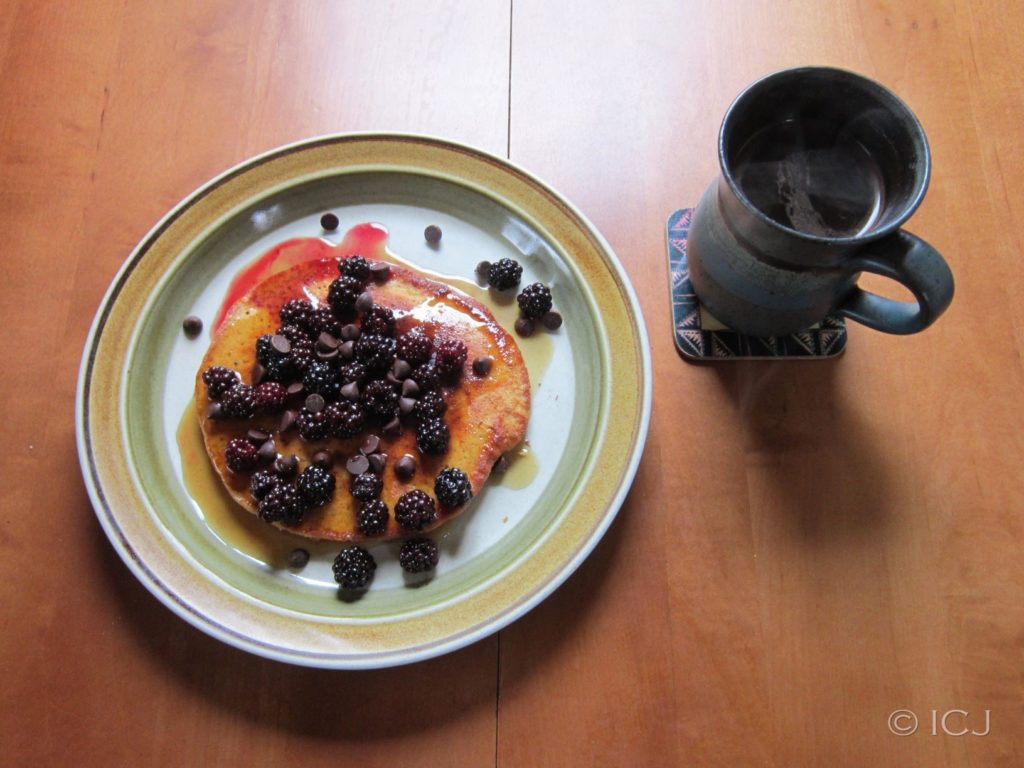
My first experiment in eating local took place in spring of 2010, six full weeks in March and April. Strangely enough it was my first time observing Lent and I was doing so shortly following my departure from formal religion. For a recovering Evangelical, perhaps practicing a ritual dearer to Catholics than Protestants was a form of protest? Of repentance? Of exercising religious freedom? When you don’t adhere to a particular creed you are at liberty to participate in any tradition that feeds your soul.
I don’t remember what prompted the parameters that I set. At the time I was severely cash strapped, having gone through several rounds of unemployment without benefits and jobs falling through in the recession of 08-09. I was working low-wage jobs with erratic hours in a city where cost of living was already problematic. Even at 40 hours a week between two part-time jobs, minimum was not living wage. Encumbered with crippling student debt—monthly payments were more than rent at the time—I had to work more that 40 hours a week to have any margin at all. That option was not always available to me.
For most of the past year and a half my grocery budget had been $30-35 a week. Many meals of just rice and lentils, with sometimes a little cabbage on the side. Many meals of apple, homemade bread, and a few slices off a 2-lb block of the cheapest Tillamook Cheese.
I decided for Lent to eat only food grown in Washington State. I decided that my budget for doing so would be $50 a week. I had a 3-figure checking balance at the end of a good month. This was a risk, and a splurge.
Making a substance or behavior taboo is typical Lenten practice. Rather than giving something up I was committing to something. Putting my money where my mouth is. Investing in the integrity of the food system. Not self-denial for self-denial’s sake but excluding some things to make room for other (and worthier) things. One only has so much space in one’s life. Choosing abundance. Choosing mindfulness. Choosing gratitude. Repenting of, or if you prefer non-religious language, ‘turning one’s back on’ scarcity, carelessness, and greed or fear.
The daily imports I allowed myself were coffee, olive oil, yeast, and spices. I allowed for 3 exceptions each week—snacks or meals consisting of food from outside WA—but they had to fit withing the $50.
Carless, as I had been for going on 5 years, I biked and/or bussed from Shoreline to the UDistrict Farmer’s Market which is open every Saturday year-round. For the first time I foraged for whole portions of greens rather than just nibbling because the field guide said it was edible. Seattle has some generously sized and largely wild (2nd-growth but not landscaped) city parks.
I went hungry a lot.
I believe it was about halfway through the six weeks that I manage to find and afford all the ingredients for honey wheat rolls. I mas moved almost to tears by the smell of them rising. I have never been so grateful for bread.
Remembering this I wanted to make sure that I had the ingredients for honey wheat rolls before State Foodshed Day came along. Bluebird Farms popped up online. A) Bluebirds are my second favorite bird after hummingbirds, and B) The farm is, as they describe it, a plow-to-package operation. I loved their philosophy and the way they present themselves. The sampler pack seemed like a good way to start—2 lb bags of flour of five different kinds of grain. So far SOOOO good. I look forward to trying them all and finding my favorites for each recipe. Someday when I have more storage, specifically another chest freezer, I hope to buy the majority of my flour from them.
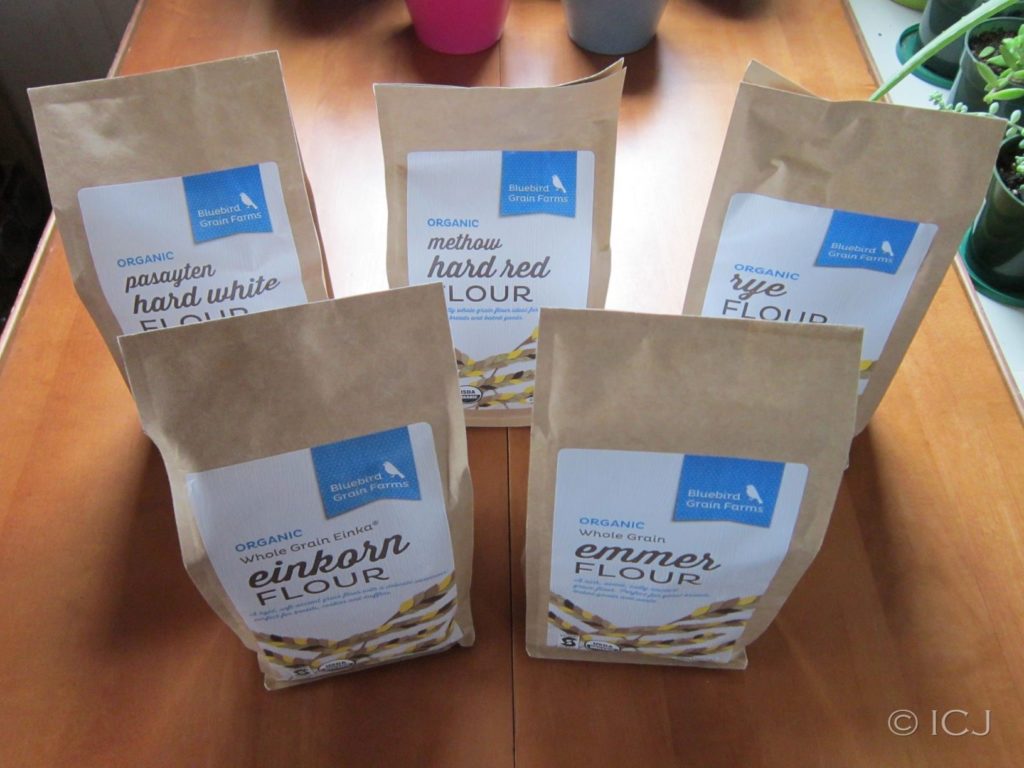
April 24 – WA State Foodshed Day
**All food grown/raised/foraged/hunted in WA excepting imports allowed on Homegrown days (coffee, olive oil, salt, and yeast) + County and State days (chocolate, butter, maple syrup, and spices that do not grow in WA).**
State Food Day dawned cool and soggy after a week+ of unseasonable warmth and drought. Perfect for cozying up in the cabin, preparing and savoring comfort food. First order of business: PANCAKE! Because pancakes.
Breakfast: Blackberry Chocolate Chip Pancake, Coffee
Pancake = Egg (Root Cellar Farm, 15 miles), kefir (Grace Harbor Farms, 211 miles), einkorn flour (Bluebird Grain, 295 miles), maple syrup (sub for the sugar), baking powder, salt.
Toppings = Blackberries (home), dark chocolate chips (Equal Exhange via PCC).
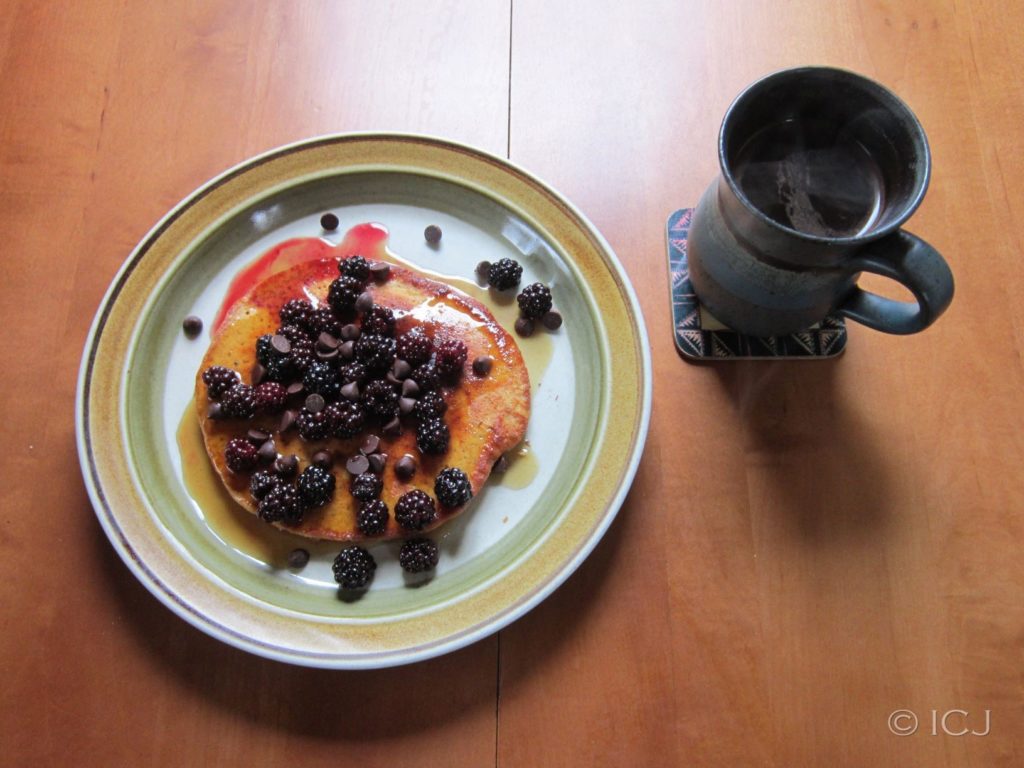
Growing up, pancakes were Swedish pancakes, which are more like crepes. Making them is a production—totally worth it, but reserved for things like Saturday brunch with all of the family or roommates around, or guests over for a breakfast-for-dinner. American pancakes happened most regularly at summer camp. 7 summers on staff x 4-10 weeks x pancakes twice a week. Better slather that with peanut butter or you’ll be bonking by 10 am. No morning snack break and lunch isn’t till noon. American pancakes belonged to camp and breakfast at diners on family road trips to CT or CO to see the grandparents, one direction or the other every summer.
I don’t know why it took me until I was 30 to realize that one of the best reasons to be a grown-up was having pancakes whenever you want. Swedish pancakes don’t make sense for fewer than 4 people but American pancakes need not be a meal for 100. I fiddled with a combination of several from-scratch recipes until I had perfected the batter of a Pancake for 1.
The kefir was an accident. One time a couple years into my pancake renaissance I didn’t have milk or half-and-half around. Kefir in pancakes is now a fixture. They are richer and fluffier that way. Yogurt works too but they turn out more dense. I’ve been buying the Grace Harbor Farms kefir for years. They are a small, really actually family farm, good keepers of land and animals, and minimally process their dairy to keep the nutrients intact. You can only buy their stuff in WA.
Later I discovered the excellent all-natural Bob’s Red Mill pancake mixes and usually have one of those around. Just 1 egg, a dollop (1/4 c?) kefir, and 1/3 cup of the dry mix. Pancake. Done.
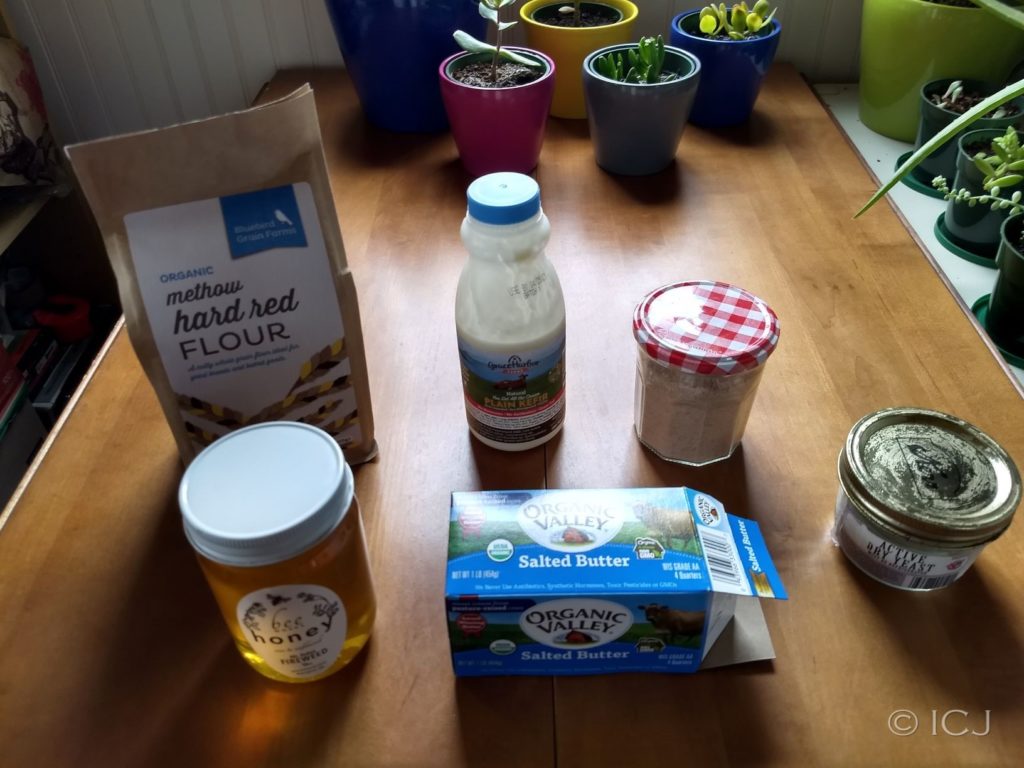
Honey wheat rolls = Hard red wheat flour (Bluebird), kefir (Grace Harbor), water, honey (Beeworks, 192 miles), butter, salt, yeast.
The recipe calls for 2 c milk. I substituted 1 c kefir and 1 c water because I wasn’t in Seattle recently enough that milk would keep. Strange with all the dairies around here that you can’t find any WA-label milk on the shelves. The Farmer’s Market in Morton doesn’t start until May or the one in Chehalis until June.
The bread recipe is out of a cookbook that I bought in Sweden while an exchange student, their answer to Betty Crocker, or more accurately, splitting the difference between Betty Crocker and Joy of Cooking. Every Swedish household has one.
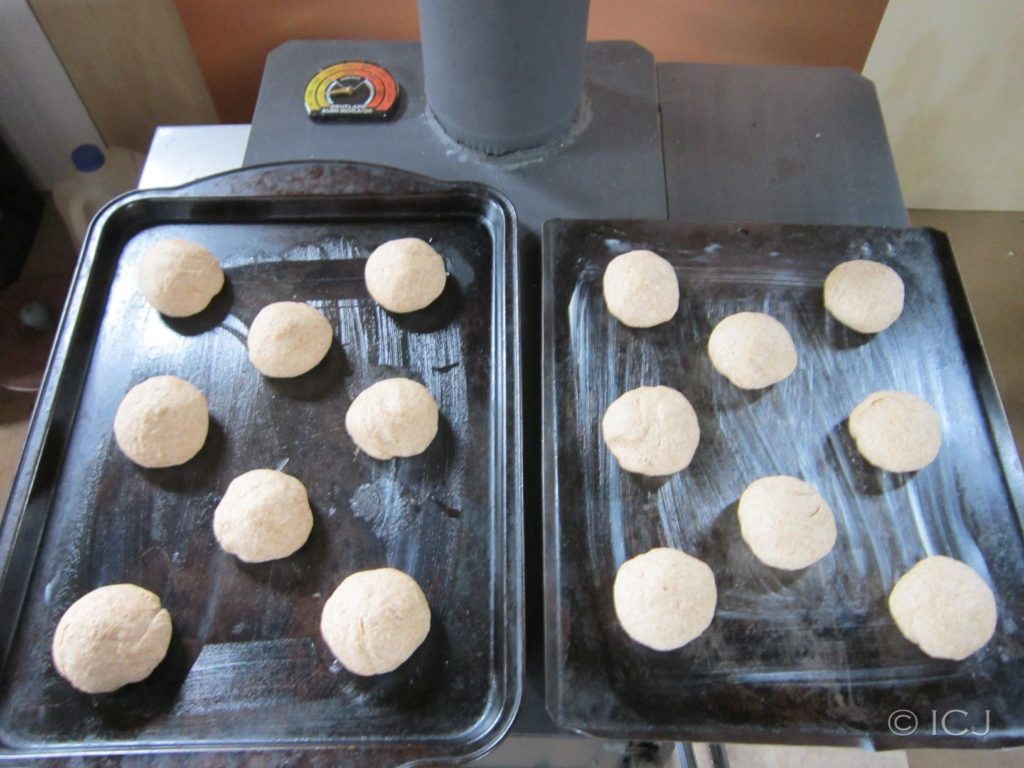
I baked the rolls in an oven given to me by a neighbor (salvaged from remodel). It is housed on a pallet in a funny little 3-sided shed with salvaged window panes, built for the purpose. My neighbor said it looks like a bus stop. It totally does. Michelle, who helped me build the shelter, named it Thistle House. It took three tries before I figured out the right combination of hose and brass fittings to run a household oven off a 20-lb propane tank. Fortunately it was already being run on propane instead of the default natural gas so I did not have to swap out the valves inside as well. Quite the rigamarole but so worth it to be able to bake. Got that thing live in January. Within a few weeks I couldn’t bake anymore for a while because my chest freezer was full.
Lunch: Potato Leek Soup, Honey Wheat Roll, Cheese
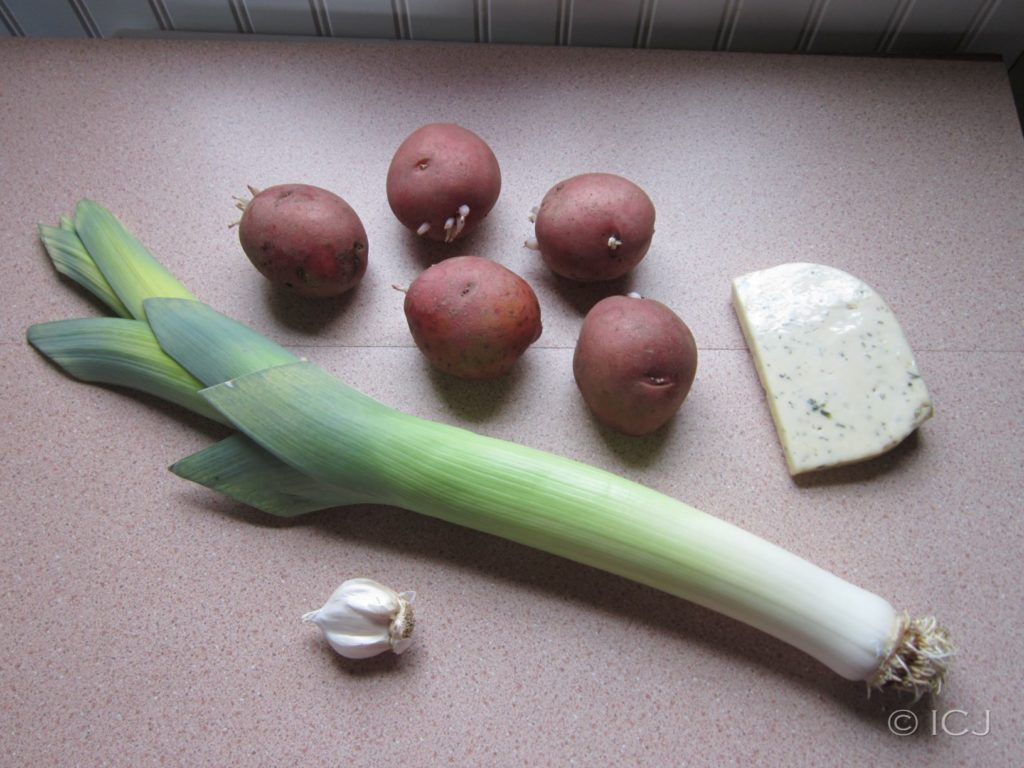
Soup = Potatoes (WA via PCC), leek (WA via PCC), garlic (Irish Eyes, 163 miles), butter, salt, pepper, cooking sherry.
The garlic comes from the remainder of a pound of seed garlic that I ordered for planting last fall. “Silver Rose” is the variety, advertised as an excellent keeper. I planted the biggest cloves from the seven most robust bulbs and kept the rest to eat. All 58 garlic plants came up and are pushing 18” high. Here’s to homegrown pesto in July!
The cheese is herb gouda from Samish Bay, 176 miles, via PCC. They are regulars at the UDistrict market in North Seattle. I bought a small wheel of their fresh Ladysmith cheese every week of the 6-week WA eating endeavor in 2010. It’s scrumptious and a great deal more affordable than the average aged artisan cheese.
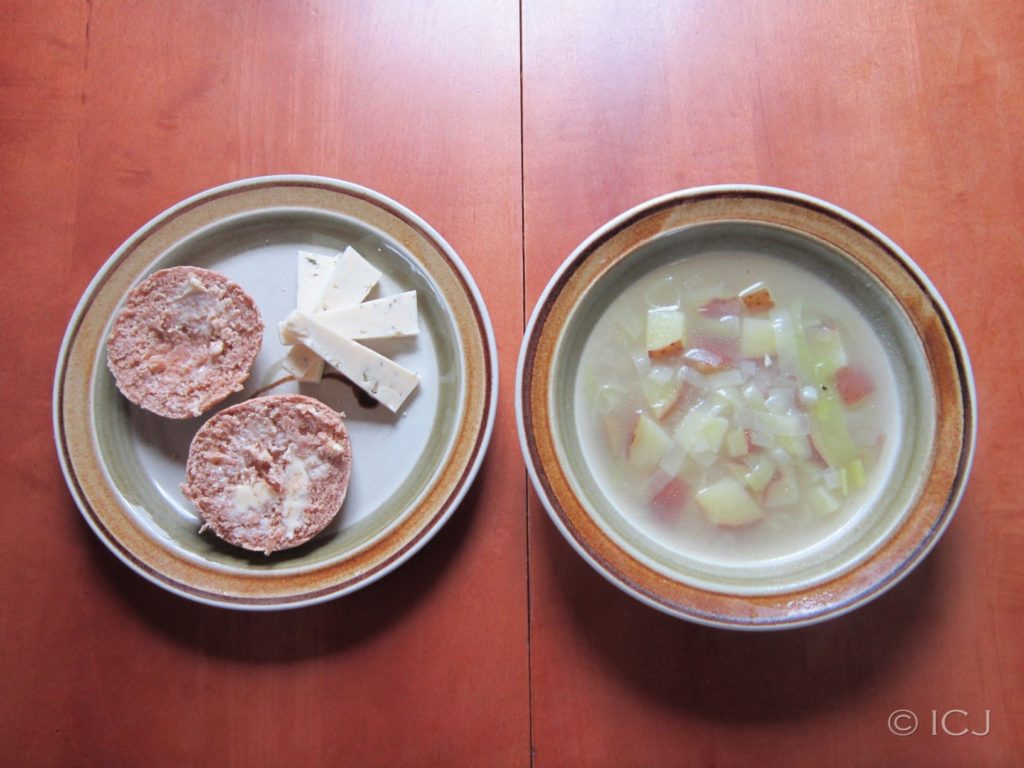
Afternoon Snack: Roll with Butter and ‘Jam’, Apple, Chocolate, Rose Hip Tea
Improv jam made of blackberries (home) and honey (Beeworks). Apple (home) now 6+ months since harvest, a month or so in the fridge after 5 months in the root cellar. Theo chocolate. Rose hips (home).
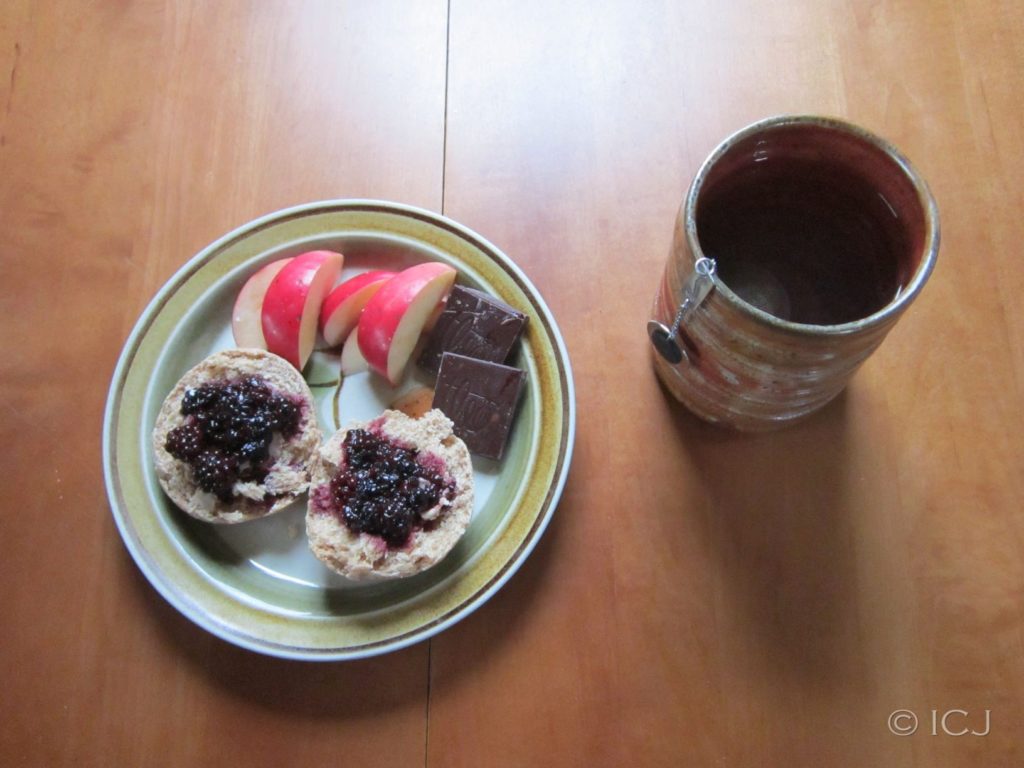
Dinner: Swedish Meatballs, Boiled Potatoes, Greens with Garlic and Butter, Hard Cider
Meatballs = Ground beef (Val, ¼ mile), ground pork (Zack and Rylee, 8 miles), shallot (home, sub for onion), bread crumbs (honey wheat roll ground in food processor), eggs (Root Cellar), allspice, salt, pepper.
The cow was raised and butchered by one of my neighbors, whose field I can see from my porch. I have visited the shed where the pig lived. Its keepers have been to my house for dinner.
I have been making my family’s multi-generation Swedish meatball recipe for years. This is the best they have ever turned out. Most of them I’ve made since I started eating meat again in 2013 were from Seattle farmer’s market beef and pork so that is saying a lot.
Potatoes (WA via PCC) with a pinch of salt.
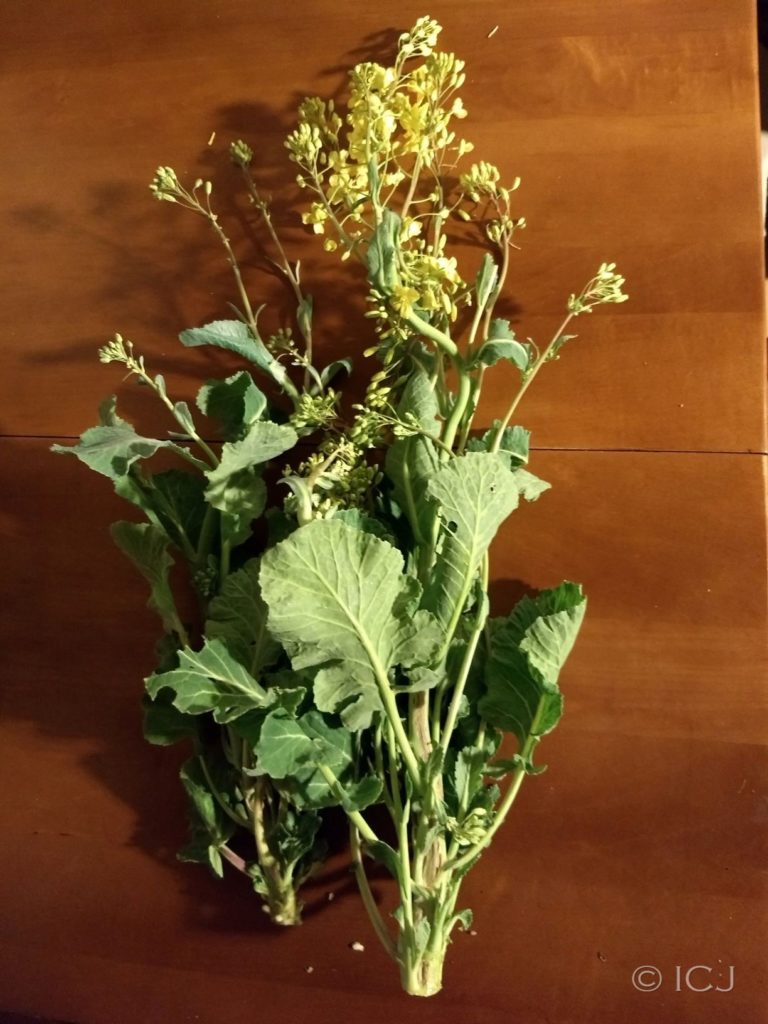
The greens I sauteed were young leaves pulled off the flower shoots of a nonsense brassica. The seed packet imagined they were brussels sprouts. Only two plants out of twelve saw fit to behave like brussels sprouts at all, and did not do a very convincing job. Several tried to be cabbages at the top of a foot tall stem. Others looked like really scraggly sprouting broccoli or kale. Last fall’s leaves were moth eaten, mouse eaten, drought stressed, and totally unappetizing. I waited to put the plants in the ground until the stems were woody enough that mice would not eat the whole thing. Had they been actual brussels sprouts I would have continued taking better care of them.
The new spring leaves were pretty good. Some tasted more like broccoli and some more like cabbage, all with the texture of young kale. Plant genetics are fascinating, especially brassicas. One species takes on a staggering number of forms and a range of flavors. If two brassica varieties are flowering at the same time in proximity, the seeds can be crossed up and turn out as whatever they please in the brassica range.

Hard cider. 2 ingredients: Organic apples (grown in Yakima), yeast. Tieton Cider Works, 122 miles. Over the Cascades and straight on til morning. This stuff is delicious. Not too dry, not too sweet. I found it at Grocery Outlet in Chehalis earlier this year and have bought it several times.
Glorified peasant food. The quality of the ingredients makes it a feast. It makes me happy to think that my Scandinavian farmer ancestors sat down in front of a plate like this many times.
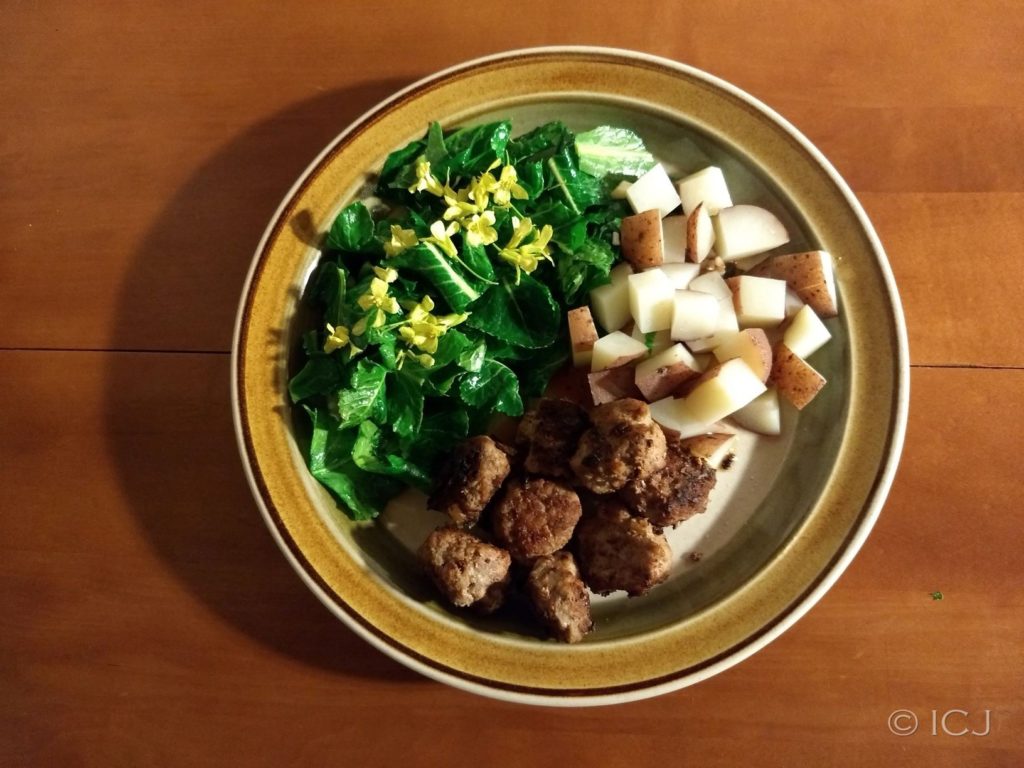
I have been conscious of the global food system and the pitfalls thereof for going on 25 years now. At the time of my first in-state eating exercise it had been over a decade, during which I had spent a fair amount of time participating in both hands-on projects and policy initiatives addressing the problems of access to sufficient nourishing food and of growing food in environmentally responsible ways.
Even so, a month and a half of endeavoring to feed myself mostly in-state left me deeply unsettled. It is arguably easier to eat local in WA than any other state in the U.S. thanks to our moderate maritime climate and two starkly different bio-regions east and west of the Cascades. It’s still a serious challenge. Without the opportunity to amass and preserve seasonal produce for months in advance, half the year it would be nearly impossible.
Food is deeply embedded in ritual. Rightly so. It seems to me that sourcing of food should consistently be approached with reverence, not just its preparation and consumption on special occasions. My vision for Edgewild is to be putting this philosophy into practice and inspiring other to do the same.
